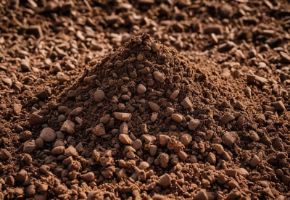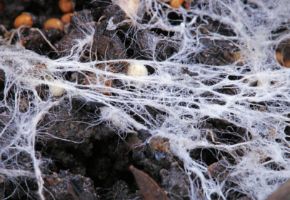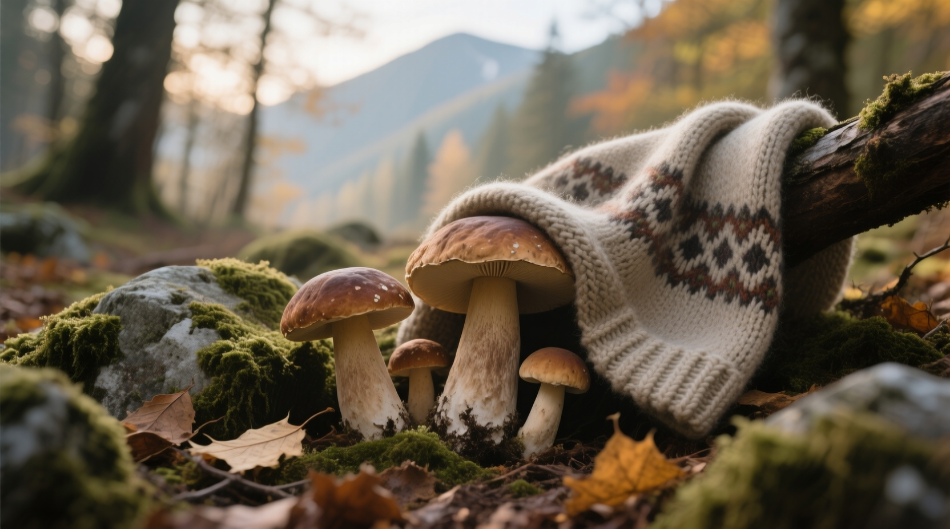Cold in the mountain environment: a constant challenge
Altitude and atmospheric pressure
As altitude increases, atmospheric pressure decreases significantly. At 3000 meters above sea level, the pressure is about 70% of that recorded at sea level, resulting in reduced oxygen availability. This factor significantly affects the metabolic processes of fungi, forcing them to develop respiratory efficiency mechanisms superior to their lowland counterparts.
Alpine fungi show particular enzymatic adaptations that allow them to extract more energy from smaller amounts of oxygen. These adaptations include:
- Greater efficiency of cytochromes in mitochondria
- Production of fungal hemoglobin (oxygen-binding protein)
- Modifications in the lipid composition of membranes to facilitate gas exchange
Temperature and thermal excursions
Temperatures in the alpine environment can vary by over 20°C within 24 hours, creating considerable thermal stress for organisms. Mountain fungi have developed various strategies to cope with these fluctuations:
- Production of natural cryoprotectants: compounds like glycerol and sorbitol that lower the freezing point of cellular fluids
- Modifications of membrane fluidity: increasing the proportion of unsaturated fatty acids in cell membranes to maintain fluidity at low temperatures
- Synthesis of antifreeze proteins: that prevent the formation of damaging ice crystals inside cells
Ultraviolet radiation
The rarefied atmosphere at high altitudes offers less protection from UV radiation, which can damage DNA and other cellular structures. Mountain fungi produce specialized pigments like melanin that act as a protective screen. Some alpine fungi contain melanin concentrations up to 30% higher than lowland species, giving them that characteristic dark coloration often observed in high-altitude fungi.
Nutrient availability and seasonality
The growing season in the mountains is considerably shorter than in the lowlands, often limited to 3-4 months per year. Alpine fungi have developed accelerated life cycles and greater efficiency in nutrient absorption. Many mountain fungi form closer mycorrhizal relationships with plants, creating highly efficient symbiotic systems.
| Parameter | Lowland (200m) | Mid-mountain (1500m) | High mountain (3000m) |
|---|---|---|---|
| Avg. annual temp. | 12-15°C | 6-8°C | 0-2°C |
| Daily thermal excursion | 8-10°C | 12-15°C | 18-25°C |
| Fungi growing season | 6-8 months | 4-5 months | 2-3 months |
| UV radiation (max index) | 6-8 | 9-11 | 12-15 |
| Atmospheric pressure (hPa) | 1000 | 850 | 700 |
To learn more about the characteristics of mountain ecosystems, the Italian Institute for Environmental Protection and Research offers detailed data and updates on the Italian environmental situation.
Physiological adaptations to cold
Modifications of membrane composition
Cell membranes are the first line of defense against the cold and alpine fungi have developed highly specialized membranes. At low temperatures, membranes tend to lose fluidity, compromising vital cellular functions. Mountain fungi solve this problem by modifying the lipid composition of their membranes:
- Increase in the proportion of unsaturated fatty acids (oleic, linoleic, linolenic)
- Shortening of fatty acid chains to increase fluidity
- Modifications in the sterol/phospholipid ratio to stabilize membranes
A study conducted on 50 species of alpine fungi demonstrated that high-altitude species present on average 65% unsaturated fatty acids compared to 45% in lowland species, an adaptation that maintains membrane fluidity even at temperatures near zero.
Production of cryoprotective substances
Alpine fungi synthesize and accumulate various substances that function as biological "antifreeze". These compounds include:
- Polyols: glycerol, mannitol, sorbitol and trehalose which lower the freezing point of intracellular fluids
- Antifreeze Proteins (AFPs): that bind to ice crystals preventing their growth
- Exopolysaccharides: that create a protective barrier around the hyphae
Trehalose, in particular, is extremely effective in protecting cellular structures during freezing and subsequent thawing. Some alpine fungi can accumulate trehalose up to 15% of their dry weight when exposed to near-freezing temperatures.
The ability of alpine fungi to produce antifreeze proteins has attracted the interest of the food and medical industries. These proteins could be used to improve the preservation of frozen foods or to preserve organs and tissues for transplants.
DNA repair mechanisms
High UV radiation at high altitudes causes DNA damage that must be efficiently repaired. Mountain fungi possess particularly efficient DNA repair systems, including:
- Nucleotide excision repair (NER) system
- Base excision repair (BER) system
- Specialized photolyases to repair UV damage
These repair capabilities are so efficient that some alpine fungi show mutation rates 40% lower than similar lowland species, despite exposure to more intense radiation.
Metabolism at low temperatures
Fungal metabolism generally slows with decreasing temperature, but alpine fungi maintain enzymatic activity at sub-zero temperatures through:
- Psychrophilic enzymes (cold-adapted) with optimum temperature shifted toward lower temperatures
- Greater expression of key enzymes in energy metabolism
- Increased concentration of enzymatic cofactors
| Adaptation mechanism | Function | Example species |
|---|---|---|
| Modification of membrane fatty acids | Maintain membrane fluidity | Xerocomus chrysenteron, Suillus luteus |
| Trehalose production | Intracellular cryoprotection | Hygrophorus marzuolus, Cantharellus cibarius |
| Synthesis of antifreeze proteins | Prevent ice formation | Albatrellus ovinus, Boletus edulis |
| Melanic pigmentation | Protection from UV radiation | Hortiboletus rubellus, Russula integra |
| Psychrophilic enzymes | Maintain metabolic activity at low T | Calocybe gambosa, Craterellus cornucopioides |
Dormancy and life cycles
Alpine fungi have developed dormancy strategies that allow them to survive during long winters. These include:
- Formation of sclerotia: compact masses of hyphae that survive under snow
- Production of spores with thick protective walls
- Reduction of metabolism by up to 95% during the coldest periods
Some alpine fungi can remain dormant for up to 9 months per year, then complete their life cycle within a few weeks during the short alpine summer.
For more information on the physiological adaptations of extremophile organisms, the National Museum of Natural History in Paris conducts cutting-edge research in this field.
Most common alpine species and where to find them
Fungi of high-altitude conifers
Conifer forests above 1500 meters host specialized fungal communities, particularly mycorrhizal fungi that form symbiotic relationships with firs, larches, and Swiss stone pines.
Suillus plorans: typical of Swiss pine forests between 1600 and 2200 meters, this fungus is easily recognizable by its sticky brown-olive cap and stem covered with granulations. It grows in late summer and autumn, often in numerous groups. Its compact flesh and pleasant flavor make it an appreciated edible, provided the sticky cuticle is removed.
Hygrophorus marzuolus: known as the "sleeping one" or "March fungus", it appears at the edges of snow in spring, often when still partially covered by snow. It prefers beech and fir forests between 1000 and 1800 meters. It is considered a delicacy for its firm flesh and intense aroma, but harvesting requires attention to avoid confusion with toxic spring species.
Fungi of alpine pastures and high-altitude meadows
Above the tree line, between 2000 and 3000 meters, specialized fungal communities develop that include saprophytic and mycorrhizal species with dwarf shrubs and herbaceous plants.
Cortinarius anomalus: this violet cortinarius grows in clearings and at the edges of subalpine woods, forming mycorrhizae with dwarf willows and junipers. The convex violet-gray cap and rust-colored lamellae make it recognizable. It is not edible and indeed, like many cortinarius, can be toxic.
Bovista nigrescens: small saprophytic fungus of alpine pastures, appears as a white ball that becomes brown with maturation and opens to release spores. It grows in summer after thunderstorms and is edible when young when the gleba is still white and compact.
Fungi of beech and spruce mountain forests
Between 800 and 1600 meters, beech and spruce forests host some of the most sought-after species by mycophagists.
Boletus edulis: the celebrated porcino finds an ideal habitat in the mountains, especially in beech and fir forests between 1000 and 1500 meters. Mountain versions often present slightly different characteristics: high-altitude porcini tend to have darker caps and more compact flesh compared to lowland ones.
Cantharellus cibarius: the chanterelle is common in both coniferous and deciduous mountain forests, where it forms extensive circles in mossy clearings. The alpine version often presents more intense colorations and higher concentration of aromas, probably in response to more extreme environmental conditions.
| Species | Altitudinal range (m) | Fruiting period | Preferred habitat |
|---|---|---|---|
| Suillus plorans | 1600-2200 | July-September | Swiss pine forests |
| Hygrophorus marzuolus | 1000-1800 | March-June (depending on snowmelt) | Beech and fir forests |
| Boletus edulis | 800-1800 | June-October | Beech, fir, chestnut forests |
| Cantharellus cibarius | 600-2000 | June-September | Deciduous and coniferous forests |
| Cortinarius anomalus | 1800-2500 | July-September | Subalpine clearings with dwarf shrubs |
| Albatrellus ovinus | 1200-2000 | August-October | Spruce and larch forests |
Rare fungi and alpine endemisms
The Alps host numerous fungal endemisms, species that evolved in isolation during glaciations and that are now limited to specific mountain areas.
Hericium flagellum: this rare lion's mane-shaped fungus grows on dead spruce trunks in ancient forests above 1500 meters. It is a protected species in many regions due to its rarity and ecological importance.
Leucopaxillus montanus: massive white fungus that grows in circles in high-altitude meadows. It is characterized by an intense farinaceous odor and is not edible due to its bitter taste and leathery consistency.
Harvesting zones by altitude
The distribution of fungi along the altitudinal gradient is not uniform but follows precise patterns:
- Foothill zone (400-800 m): rich in thermophilic species, with spring and autumn fruiting
- Mid-mountain zone (800-1500 m): maximum fungal diversity, with summer and autumn species
- Subalpine zone (1500-2200 m): specialized fungi associated with conifers prevail
- Alpine zone (2200-3000 m): poor but specialized communities, with fruiting concentrated in summer
About 68% of Italian fungal species are concentrated between 800 and 1500 meters above sea level, while only 12% exceed 2000 meters, demonstrating how altitude is a limiting factor for fungal diversity.
Mountain mushrooms and cholesterol control
Hypocholesterolemic action mechanisms
Mushrooms act on cholesterol control through multiple synergistic mechanisms, which include:
Inhibition of intestinal cholesterol absorption: the beta-glucans and other soluble fibers present in mushrooms form a viscous gel in the intestinal lumen that reduces the absorption of dietary cholesterol by 15-30% according to clinical studies.
Modulation of hepatic synthesis: bioactive compounds like natural lovastatins and phenolic acids inhibit the HMG-CoA reductase enzyme, key in endogenous cholesterol synthesis.
Increase in biliary excretion: mushrooms stimulate the excretion of bile acids, forcing the liver to use more cholesterol to synthesize new ones.
Modulation of intestinal microbiota: fermentable fungal fibers promote the growth of beneficial bacteria that produce short-chain fatty acids, which in turn reduce hepatic cholesterol production.
Mountain species with hypocholesterolemic properties
Several species of alpine fungi present particularly high concentrations of compounds beneficial for lipid control:
Pleurotus ostreatus (Oyster Mushroom): although not exclusive to mountains, the alpine version of this fungus contains up to 2.7% natural lovastatin by dry weight, one of the highest concentrations in the fungal kingdom. Studies have shown that regular consumption of Pleurotus can reduce LDL cholesterol by 10-15% in hypercholesterolemic subjects.
Ganoderma applanatum: this wood-decay fungus common in mountain deciduous forests contains triterpenoids and polysaccharides with documented hypocholesterolemic activity. Traditionally used in Eastern medicine, it is now also available in specific supplements.
Agaricus bisporus (Button Mushroom): the common champignon, when grown in mountain environments, develops higher concentrations of β-glucans and chitin. Research on 50 subjects demonstrated that consumption of 100g per day of Agaricus for 4 weeks reduced total cholesterol by 8.7%.
Beta-glucans: the hidden protagonists
Beta-glucans are structural polysaccharides of the fungal cell wall with demonstrated hypocholesterolemic properties. Mountain fungi, due to environmental stress, produce beta-glucans with more branched structures and higher molecular weights, characteristics associated with greater efficacy.
The mechanisms through which beta-glucans reduce cholesterol include:
- Increased intestinal viscosity and reduced cholesterol absorption
- Fermentation in the colon with production of propionate that inhibits hepatic synthesis
- Modulation of gene expression of enzymes involved in lipid metabolism
Mushrooms contain on average 3-5% beta-glucans by dry weight, with some alpine species reaching 8%. For comparison, oats - a known source of beta-glucans - contain about 2-3%.
Cold and fungi: challenge overcome!
The world of alpine fungi represents a fascinating example of evolutionary adaptation to extreme environmental conditions. Through complex physiological mechanisms involving modifications of membrane composition, the production of cryoprotective substances and efficient DNA repair systems, these species have conquered ecological niches inhospitable to many other organisms. The mountains, with their unique challenges, have shaped specialized fungal communities, each with distinctive characteristics along the altitudinal gradient.
Beyond their undoubted scientific and ecological interest, many mountain mushrooms also offer benefits for human health, particularly regarding cholesterol control. Species like Pleurotus ostreatus, Ganoderma applanatum, and even the common button mushroom when grown in mountain environments, develop high concentrations of beta-glucans, natural lovastatins, and other bioactive compounds with demonstrated hypocholesterolemic properties.
However, the harvesting and study of these fungi must occur with maximum respect for mountain ecosystems, already fragile and vulnerable to climate change. Sustainable harvesting practices, habitat conservation and further scientific research are essential to preserve this precious mycological heritage and discover new applications of the extraordinary properties that alpine fungi continue to reveal.
The intense cold, ultraviolet radiation and short growing season, from seemingly insurmountable obstacles, have thus transformed into powerful drivers of biological and chemical diversity, demonstrating once again the resilience and ingenuity of life even in the most extreme environments of our planet.
The kingdom of fungi is a universe in continuous evolution, with new scientific discoveries emerging every year about their extraordinary benefits for gut health and overall well-being. From now on, when you see a mushroom, you will no longer think only of its taste or appearance, but of all the therapeutic potential contained in its fibers and bioactive compounds. ✉️ Stay Connected - Subscribe to our newsletter to receive the latest studies on: Nature offers us extraordinary tools to take care of our health. Fungi, with their unique balance between nutrition and medicine, represent a fascinating frontier we are only beginning to explore. Continue to follow us to discover how these extraordinary organisms can transform your approach to well-being.Continue your journey into the world of fungi










